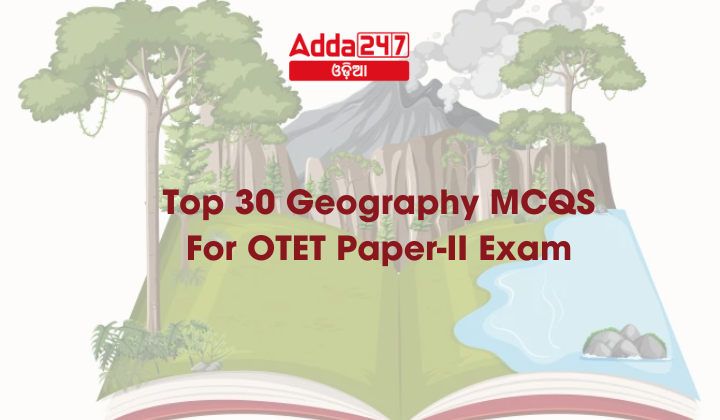The Odisha Teacher Eligibility Test (OTET) is a crucial examination for aspiring teachers in Odisha. Geography is a significant part of the syllabus, especially for Paper-II, which focuses on Social Studies. Here are the top 30 multiple-choice questions (MCQs) to help candidates prepare for the Geography section of OTET Paper-II.
Top 30 Geography MCQS For OTET Paper-II Exam
- Which Greek philosopher originally proposed the concept of dividing the Earth into climatic zones based on the distance from the equator?
A) Socrates
B) Plato
C) Parmenides
D) Aristotle
Answer: C) Parmenides - According to Parmenides and Aristotle, which zone is located closest to the equator and is known for being extremely hot?
A) Temperate Zone
B) Torrid Zone
C) Frigid Zone
D) Polar Zone
Answer: B) Torrid Zone - What name did Aristotle give to the region that Parmenides thought was too hot for living and is located around the equator?
A) Torrid Zone
B) Temperate Zone
C) Frigid Zone
D) Equatorial Zone
Answer: A) Torrid Zone - Which climatic zone, according to both Parmenides and Aristotle, is considered to be perpetually frozen and uninhabitable?
A) Temperate Zone
B) Torrid Zone
C) Frigid Zone
D) Glacial Zone
Answer: C) Frigid Zone - In which zone do both philosophers believe is the only habitable area, lying between the Frigid Zone and the Torrid Zone?
A) Equatorial Zone
B) Polar Zone
C) Tropical Zone
D) Temperate Zone
Answer: D) Temperate Zone - Which layer of the Earth is composed of solid iron and nickel due to extreme pressure?
A. Crust
B. Mantle
C. Outer Core
D. Inner Core
Answer: D. Inner Core - The asthenosphere is characterized by which of the following properties?
A. It is a rigid and brittle layer.
B. It is partially molten and ductile.
C. It is composed primarily of solid iron.
D. It is located above the lithosphere.
Answer: B. It is partially molten and ductile. - What is the primary source of material for laboratory analysis obtained from volcanic eruptions?
A. Basalt
B. Granite
C. Magma
D. Meteorites
Answer: C. Magma - The boundary between the Earth’s crust and the upper mantle is known as the:
A. Conrad Discontinuity
B. Mohorovicic (Moho) Discontinuity
C. Gutenberg Discontinuity
D. Lehmann Discontinuity
Answer: B. Mohorovicic (Moho) Discontinuity - Which layer of the Earth’s interior is responsible for generating the planet’s magnetic field?
A. Lithosphere
B. Asthenosphere
C. Outer Core
D. Inner Core
Answer: C. Outer Core - The Earth’s mantle extends to a depth of approximately:
A. 30 km
B. 700 km
C. 2,900 km
D. 5,150 km
Answer: C. 2,900 km - Which of the following layers is in a solid state despite high temperatures due to immense pressure?
A. Crust
B. Outer Core
C. Inner Core
D. Asthenosphere
Answer: C. Inner Core - The mantle constitutes what percentage of the Earth’s total volume?
A. 1%
B. 16%
C. 31%
D. 83%
Answer: D. 83% - What type of rocks primarily make up the continental crust?
A. Basalt
B. Granite
C. Iron
D. Nickel
Answer: B. Granite - The density of the oceanic crust is approximately:
A. 2.7 g/cm³
B. 3.0 g/cm³
C. 5.7 g/cm³
D. 7.9 g/cm³
Answer: B. 3.0 g/cm³ - What is the geosphere?
a) The water parts of the planet
b) The living components of the Earth
c) The gaseous component above the surface of the Earth
d) The elements that form the crust and core of the Earth
Answer: d) The elements that form the crust and core of the Earth - Which process is part of the rock cycle?
a) Transpiration
b) Condensation
c) Erosion
d) Photosynthesis
Answer: c) Erosion - How does the hydrosphere interact with the geosphere?
a) It provides gases for the geosphere
b) It provides the necessary moisture to weather and erode rocks
c) It forms rain clouds
d) It absorbs sunlight for plants
Answer: b) It provides the necessary moisture to weather and erode rocks - What is the primary role of the atmosphere in relation to the geosphere?
a) To provide water
b) To support plant and animal life
c) To provide heat and energy for the breakdown and erosion of rock
d) To form rain clouds
Answer: c) To provide heat and energy for the breakdown and erosion of rock - Which of the following is NOT a component of the biosphere?
a) Organic matter that has not yet decayed
b) Minerals and rocks
c) Plants and animals
d) Microorganisms
Answer: b) Minerals and rocks - Which layer of the atmosphere is closest to Earth?
a) Stratosphere
b) Mesosphere
c) Troposphere
d) Exosphere
Answer: c) Troposphere - How does the hydrosphere affect the atmosphere?
a) By providing a solid surface for life
b) By contributing to the formation of rain clouds through evaporation
c) By reflecting the sun’s energy
d) By providing heat and energy
Answer: b) By contributing to the formation of rain clouds through evaporation - What is one example of how the geosphere impacts other spheres?
a) It absorbs the sun’s energy
b) It provides gases to the atmosphere
c) It reflects the sun’s energy to the atmosphere
d) It provides a habitat for living organisms
Answer: c) It reflects the sun’s energy to the atmosphere - What process in the hydrosphere helps support the water cycle?
a) Erosion
b) Transpiration
c) Weathering
d) Photosynthesis
Answer: b) Transpiration - Which statement best describes the interaction between the biosphere and the other spheres?
a) The biosphere depends on the geosphere for heat
b) The biosphere provides a medium for the atmosphere to form clouds
c) The biosphere receives sunlight and gases from the atmosphere, water from the hydrosphere, and a living medium from the geosphere
d) The biosphere reflects the sun’s energy to the atmosphere
Answer: c) The biosphere receives sunlight and gases from the atmosphere, water from the hydrosphere, and a living medium from the geosphere - What defines a renewable resource?
a) A resource that can never be exhausted
b) A resource that can be replenished rapidly in a limited timeframe
c) A resource that is always available in the environment
d) A resource that cannot be replaced once used
Answer: b) A resource that can be replenished rapidly in a limited timeframe
Explanation: Renewable resources are those that can be regenerated or replaced naturally in a short period. Examples include wind, water, and solar energy. - Which of the following is an example of a non-renewable resource?
a) Wind
b) Solar energy
c) Coal
d) Water
Answer: c) Coal
Explanation: Non-renewable resources are those that cannot be easily replaced once they are depleted. Coal, oil, and natural gas are prime examples because they take millions of years to form. - What is the primary difference between renewable and non-renewable resources?
a) Renewable resources are always cheaper than non-renewable resources
b) Renewable resources can be replenished quickly, while non-renewable resources cannot
c) Non-renewable resources are more environmentally friendly
d) Renewable resources are always more abundant than non-renewable resources
Answer: b) Renewable resources can be replenished quickly, while non-renewable resources cannot
Explanation: The key distinction is that renewable resources can be regenerated within a human lifespan, whereas non-renewable resources are finite and take geological timescales to form. - Which of the following statements about natural resources is correct?
a) Non-renewable resources are always cheaper than renewable resources
b) Renewable resources are limited and cannot be replaced once used
c) Natural resources are only used for economic activities
d) Natural resources are essential for the production of energy, industrial goods, and food
Answer: d) Natural resources are essential for the production of energy, industrial goods, and food
Explanation: Natural resources are fundamental for various sectors including energy production, industrial manufacturing, and agriculture, playing a critical role in sustaining human life and economic activity. - Why is responsible management of natural resources crucial?
a) To ensure resources are used up quickly
b) To prevent the complete depletion of non-renewable resources
c) To increase the consumption rate of natural resources
d) To make renewable resources non-renewable
Answer: b) To prevent the complete depletion of non-renewable resources








